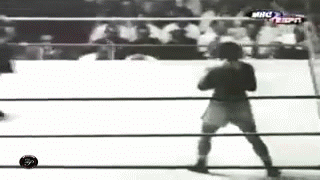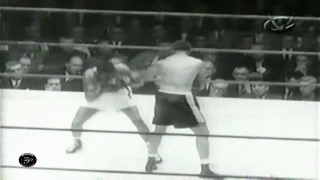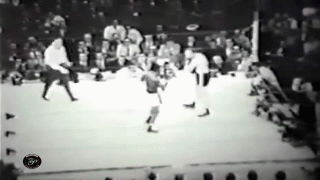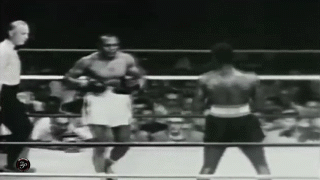
Many of my regular readers will recall my constant referencing of the "Golden Age of Boxing" and wonder just how good a sport could have been thirty, forty or even fifty years ago. There were no readily available performance enhancing drugs, cardiovascular training methods were archaic, and strength and conditioning didn't exist. Boxing unlike every other sport in the world, has not gone forward in leaps and bounds technically since 50 years ago. In fact it's interesting to note that Floyd Mayweather, considered one of the best fighters pound for pound and the best defensive fighter on the planet, is called a "throw back" due to his old school fighting style that confounds today's square on, combination spamming fighter.
From the 1890s to the 1960s boxing was the world's favourite sporting event and almost every healthy young man strapped on the gloves at some point. Whether it be the gentleman's clubs of London who wagered on and negotiated the bouts, or the young men with no saleable skills aside from their punch, boxing was practised and speculated by a huge portion of society. Due to the huge pool of fighters and the regularity with which they fought, defensive genius came to be of paramount importance. Watch a fighter such as Archie Moore who fought 219 recorded professional fights, then watch a man such as Ricky Hatton and you'll notice that a man who fights a couple of times a year until the age of 30 never has to correct the errors in his dangerous, self sacrificing style. When you fight as often Archie Moore or his contemporaries did, safety and career longevity become of great importance. Consequently there were a great many knockout artists, counter punchers and defensive geniuses around in the 1950s who deserve the attention of the combat sports student today.
Today I have teamed up with our fantastic media man, Zombie Prophet, to examine and comment on some of the high quality gifs he has assembled from the 1950s boxing archives. This is part one of a two part series on the 1950s and if it goes well we hope to do other decades as well so do let us know what you think!
Archie Moore versus Yvon Durelle - 1959
Our first knockout comes courtesy of the aforementioned Archie Moore. Affectionately nicknamed "The Old Mongoose" in his time, Moore became the world light heavyweight champion in 1952 at the age of 36, and ruled until 1962 when he abandoned the title. Moore had met the Canadian, Yvon Durelle in 1958 and had been floored 4 times in the opening rounds before coming back to knock Durelle out in the tenth round, showing the heart of a true champion. In 1959 at age 43, Moore defended his title again in a hotly anticipated rematch against "The Fighting Fisherman".

This is the last of four knockdowns and demonstrates Moore's wiliness in action. Almost every other fighter would be swarming on Durelle and swinging at his head - instead Moore performs an inside slip, towards Durelle's powerful right hand (a signature of Moore) and delivers a ripping left uppercut to the Canadian's body. They pivot around and Moore dispatches his winded foe with a few good punches to the head to put him on his knees for the count.
Floyd Patterson versus Archie Moore - 1956When Rocky Marciano retired as the undefeated heavyweight champion of the world it was decided that Patterson and Moore were the most deserving contenders. In a true match of experience versus youth as Patterson was just 21 years of age. Patterson was the charge of Cus D'amato who many of you will remember was Mike Tyson's adoptive father and trainer, and as such fought with what the newspapers dubbed a "peek-a-boo" style.

Many great classical style boxers - those who enjoy using the right hand to parry jabs in order to economize on footwork - have proven susceptible to a leaping left hook behind their right hand which is often forward of their chin and ready to parry jabs. Joe Louis was dropped by numerous opponents who shouldn't have given him any trouble with surprise left hooks, and here Archie Moore meets Floyd Patterson's money punch. Patterson's left hook from the deep crouch has been called the "Kangaroo Punch" or more commonly "The Gazelle Punch" and despite the similarities in training that he and Mike Tyson underwent, Tyson's leaping left hook never really captured the distance or grace of Patterson's. Patterson finishes the fight with the hand speed that he was known for. Before the emergence of Cassius Clay (later Muhammad Ali), Patterson was considered the fastest punching heavyweight ever and he certainly carried a power that Ali never rivalled.
Floyd Patterson versus Pete Rademacher - 1957
Pete Rademacher is an interesting case as he is the only man in boxing history to be given a title fight in his professional debut. A sterling amateur record and an olympic gold medal did support Rademacher's case for a title shot, and he certainly backed it up when he dropped Patterson several times in the opening rounds. Patterson rallied soon after however and put Rademacher down for the count in the sixth round.

Though Patterson was known for his left hook he was also a powerful right handed puncher and it was this tool that he used to fell Rademacher. Notice that Patterson clips Rademacher twice with right hooks as he is exiting the pocket. In fact the first right hand is thrown as Rademacher is pushing Patterson away.
Jersey Joe Walcott versus Ezzard Charles - 1951
You've probably all read my gushings over this punch and Jersey Joe before, but this is one of the finest fight finishers I have seen to this day and I don't anticipate there being many better before I'm gone. Jersey Joe Walcott is possibly the savviest fighter in boxing; impoverished for much of his career, feeding a family by working menial jobs and still having time to floor men like Joe Louis and Rocky Marciano in his evenings, Walcott is an inspiration figure and a hypnotic fighter. Ezzard Charles is perhaps the greatest light heavyweight of all time and fought many of the greatest fighters of his era and in fact ever - Walcott, Louis, Marciano.

This bout was finished with a beautiful inside slip past Charles' excellent and dangerous jab, followed by a lead uppercut / hook hybrid that caught Charles at the perfect angle as he dipped into this. The best thing about this punch? Ezzard Charles did everything right - his right hand is up, his lead shoulder is high and he doesn't telegraph the jab at all. The inside slip is fairly offbeat and the inside slip to lead uppercut counter is especially rare because it is a difficult slip followed by an awkward, short punch. The fact that Walcott did this so nonchalantly against one of the greatest technical boxers who ever lived and who had already bested Walcott twice is a credit to how bizarre Walcott's style was. I break down this counter in detail in my book, Advanced Striking.
Continues with loads more knockouts at: http://www.bloodyelbow.com/2012/9/27/3407780/greatest-knockouts-of-the-1950s-gif-tacular














































